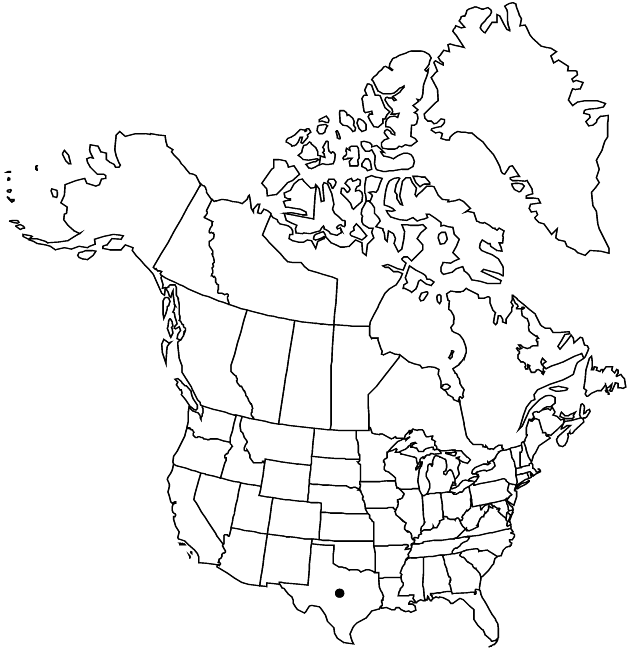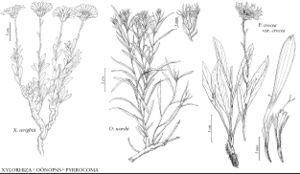Xylorhiza wrightii
Pittonia 3: 47. 1896.
Common names: Big Bend woody-aster
Illustrated
Basionym: Aster wrightii A. Gray Smithsonian Contr. Knowl. 5(6): 75. 1853
Synonyms: Machaeranthera wrightii (A. Gray) Cronquist & D. D. Keck
Subshrubs or perennials, (15–) 20–40 (–54) cm. Stems branched mostly in proximal 3/4, glabrous, densely stipitate-glandular. Leaf-blades spatulate to obovate or oblong, rarely elliptic, 5–24 mm wide, bases attenuate, not clasping, margins flat, toothed to entire (densely short-ciliate), faces densely stipitate-glandular, otherwise glabrous. Peduncles 5–10 cm. Involucres (20–) 25–35 (–40) × (20–) 28–40 (–48) mm. Ray-florets (18–) 24–32 (–34); corollas usually light blue to purple, rarely white. Style-branch appendages equaling or shorter than stigmatic lines. 2n = 12.
Phenology: Flowering Mar–May.
Habitat: Barren areas, alkaline, rocky-clay soil, gypsum or limestone flats, shaly slopes, rocky hills, dominated by saltbush, creosote bush, catclaw, and yucca
Elevation: 700–1100 m
Distribution

Tex., Mexico (Chihuahua)
Discussion
Selected References
None.
Lower Taxa
None.
... more about "Xylorhiza wrightii"
introrse +
connate +
distinct +
herbaceous +
scarious +
hirsute +
papillate +
continuous +
not clasping +
attenuate +
1-nerved +
linear;lanceolate or oblanceolate oblong or narrowly elliptic +
ribbed +
stigmatic +
barbellate +
tawny +
persistent +
30;45 +
unequal +
absent +
Big Bend woody-aster +
absent +
monomorphic +
4-ribbed +
dimorphic +
staminate +
straight +
distinct +
proximal +
1;5 +
bisexual +
dispersed +
Barren areas, alkaline, rocky-clay soil, gypsum or limestone flats, shaly slopes, rocky hills, dominated by saltbush, creosote bush, catclaw, and yucca +
singly +
indeterminate +
Present +
surrounding +
campanulate;hemispheric +
elliptic +
spatulate;obovate or oblong +
5mm;24mm +
alternate +
cauline +
spreading +
triangular +
scarious +
2-carpellate +
inferior +
attached +
anatropous +
persistent +
tough +
thick +
absent +
connate +
1-nerved +
persistent +
distinct +
falling +
lanceolate +
unequal +
Pittonia +
1896 +
pistillate +
absent +
fertile +
epaleate +
pitted +
concave;usually flat;conic +
fibrous +
exalbuminous +
modifed +
2;3 +
Illustrated +
alternate +
branched +
erect +
lanceolate +
equaling +
2-branched +
glabrous +
Xylorhiza wrightii +
Xylorhiza +
species +
shorter +
shorter to longer +
perennial +
subshrub +
